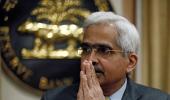'Das is friendly, but he finally does what he does. The quality of engagement is very good.'

When Shaktikanta Das took charge at Mint Road -- the 25th governor to do so -- he made a promise.
"There has to be a free, fair, objective and very frank discussion between the government and the Reserve Bank of India (RBI). I like to believe that all issues, however contentious, can be resolved through discussions."
He had moved into the biggest sea-facing room at RBI after two high-profile names signed off, Raghuram Rajan and Urjit Patel, who had some differences with the government.
As Das, who took charge as RBI's governor on December 12, 2018, enters the final 10 months of his second term, there's all-round acknowledgement that he has 'walked the talk'.
"His working style is very refreshing. He listens patiently and engages actively with stakeholders. One can articulate an opinion without any apprehension," says Rajnish Kumar, former chairman, State Bank of India.
A case in point, Kumar notes, is the deft management of the banking as well as the payments system during COVID-19.
"He stands out for decisive leadership skills. He is quite supportive and engaged closely while working out an arrangement for roping in banks to collectively infuse capital, avert a systemic crisis amid the collapse of YES Bank."
Das hit the ground running, holding meetings with all stakeholders: heads of banks -- State-run (in two instalments) and private banks, non-banking financial companies (NBFCs).
And, in a welcome break, with associations of small businesses and trade bodies as well.
His messaging was clear: 'I am reaching out to you; I am all ears.' He wrote on Twitter, now X (a first by an RBI governor).
In the process, Das buried (largely) the ivory tower tag Mint Road had come to acquire in some quarters of India Inc.
It's not that past governors did not engage with regulated entities (REs) and the wider business community.
But Das signalled accessibility -- structured interactions between lobby groups like the Confederation of Indian Industry and the Federation of Indian Chambers of Commerce & Industry had not taken place for years until then.
The Das way
To appreciate Das's approach, one needs to step back.
A complaint against Mint Road back then had been that it had turned "preachy", as a senior official at a leading lender put it.
It was more about the rulebook with little appreciation of what actually happens on the ground.
"I concede a lot of it was not desirable, and had to change, but so is a bull-in-the-china- shop approach to it," says a leading banker.
According to Shyam Srinivasan, managing director (MD) and chief executive officer (CEO) at The Federal Bank, "Das is friendly, but he finally does what he does. The quality of engagement is very good". It's a view echoed by Y S Chakravarti, MD and CEO, Shriram Finance.
"He does not come across as someone who throws his weight around. He has a very collegiate approach."

This worldview, shared by many others, has its roots in the run-up to the elections of May 2014.
The rhetoric at the pulpit was that the previous regime had indulged India Inc -- recall the reference to "phone banking".
The asset quality review (AQR) initiated by Rajan and the variance in the declared dud loans by banks which came to light was cheered on by everybody as a long-needed "clean-up".
Along the way came demonetisation on November 8, 2016 -- the RBI was not fully on board.
And even as bankers were being hauled up with the AQR, the RBI under Patel came out with its now infamous February 12 circular.
And the crowd which had backed RBI disappeared into the woodwork to claim it had gone too far.
Patel's resignation, and the events leading up to it made the RBI-North Block rupture public.
Das has a sense of timing. Like a new-year gift for small businesses by way of a one-time restructuring scheme - maximum exposure of Rs 25 crore in 2019 -- which was to be implemented by FY20.
This was critical given the fracture in the relations between Mint Road and the bosses in New Delhi.
When the proposal was first mooted -- before Das came on board -- many had echoed the Moody's Investors Service observation that "the track record of such dispensations on asset classification, when seen over the last few years, has shown that they have largely been unsuccessful in addressing the underlying stress".
His pragmatism lay in the fact that the relaxation was only for a year, but it rang goodwill.
When asked whether the move was retrograde, Das said: "It's a value judgement. I don't want to go into value judgement, whether it is retrograde or progressive. These are adjectives. I don't want to go into these."

Yet, on matters like giving a breather to NBFCs on liquidity norms and prudential norms, the infamous 12 February 2018 circular, and on governance, he has held his own.
Here Das has toed the line of his predecessors -- as evidenced by the move to tighten the asset-liability management norms for NBFCs and making private banks' chief executive remuneration linked to their standing as a good corporate citizen.
A major reform which is often mentioned is Das's decision to set up the second Regulation Review Authority (RRA 2.0) in November 2021; its recommendations came in June 2022.
This was two decades after Y V Reddy, as RBI deputy governor, set up the first RRA in 1999.
RRA 2.0 incorporated some of the best practices from global central banks.
This was in response to REs' long-held view that guidelines had to be in step with market realities.
It was an indirect way of putting it across that RBI circulars had not been adequately factoring in commerce.
RRA 2.0 has not got the recognition it deserves as a significant reform.
It's now up to REs to take advantage of the new "open-door policy" of RRA 2.0 of the RBI and foster a better engagement with it.
Strengthening governance
"One of his biggest achievements is that he took on issues which are not glamorous, like rehauling urban cooperative banks, and getting rid of archaic regulations.
"And his stress on corporate governance, the latest being the crackdown on Paytm Payments Bank," notes Ravi Duvvuru, founder and designated partner of Duvvuru & Reddy LLP, and member of the advisory group to the second Regulatory Review Authority set up by the RBI.
A sterling moment has been the RBI's handling of the pandemic and its forbearance measures.
It helped the economy tide over a critical phase.
And to Das goes the credit of hiking the governance premium in REs.
The RBI's twin interactions in May last year with the boards of state-run and private banks laid bare the shortcomings on this front.
Falling in the same family of thought is the draft omnibus framework for self-regulatory organisations.

"Once you are in the governor's chair, your New Delhi worldview anyway undergoes a change," said a former RBI official who had sat in a room adjacent to a past Mint Road chief.
It's an oblique reference to the central bank's institutional memory, though he will not tell you if he helped refresh it for the governor of his time.
It's worth recalling career bureaucrat Duvvari Subbarao's dig at then-finance minister P Chidambaram a week before his term as RBI governor came to an end: "I do hope Chidambaram will one day say, "I am often frustrated by the Reserve Bank, so frustrated that I want to go for a walk, even if I have to walk alone. But thank God, the Reserve Bank exists".
What Das, a former secretary in the Department of Revenue and Department of Economic Affairs in the finance ministry (2014-15) and who has served as India's Alternate Governor in the World Bank, Asian Development Bank, New Development Bank and Asian Infrastructure Investment Bank, has managed is to make sure that the RBI goes about its task without ruffling feathers.
Take the demand for banking licences for corporate houses.
Mint Road's Internal Working Group (IWG) to 'Review the extant ownership guidelines and corporate structure for private banks' had on 20 November 2020 made a case for large corporate and industrial houses as promoters of banks.
And also that large NBFCs with an asset size of Rs 50,000 crore and above (including those owned by corporate houses), may be considered for conversion into banks.
The trigger for setting up the IWG was "in alignment with the agenda set for the economic growth of the country to become a $5 trillion economy, there are heightened expectations for the banking sector to scale up for a greater play in the global financial system".
But instead of saying a "no" which would be taken as being adamant, the RBI played it smart.
While accepting 21 of the IWG's 31 recommendations, it said "the remaining recommendations are under examination" in its press release of November 26, 2021.
Das has deserved being ranked 'A+' in the Global Finance Central Banker Report Cards 2023 in September last year and 'Governor of the Year' by the international publication, Central Banking earlier in March.
He has played the role of governor even as he has worn the hat of an interlocutor.
The unsaid, unequivocally, is 'I also do what I do -- and listen too'.
Feature Presentation: Aslam Hunani/Rediff.com












 © 2025
© 2025